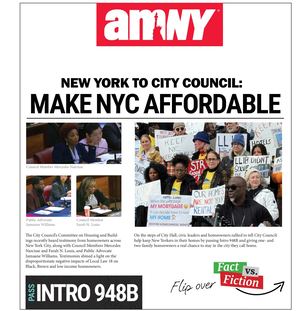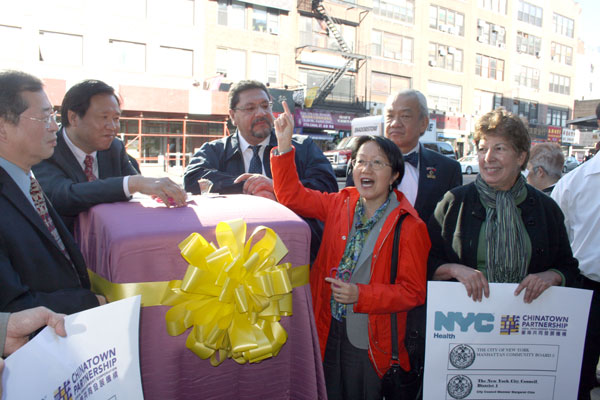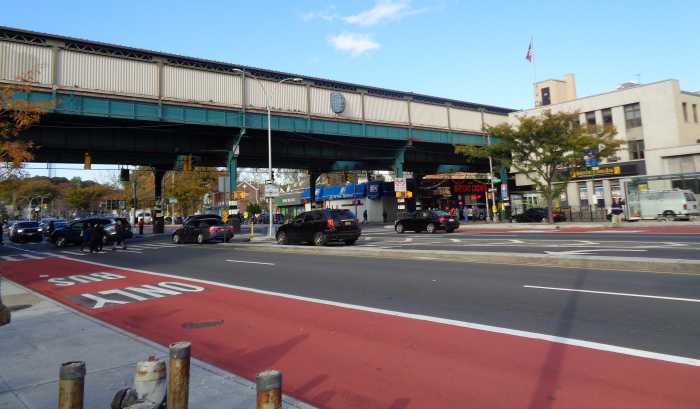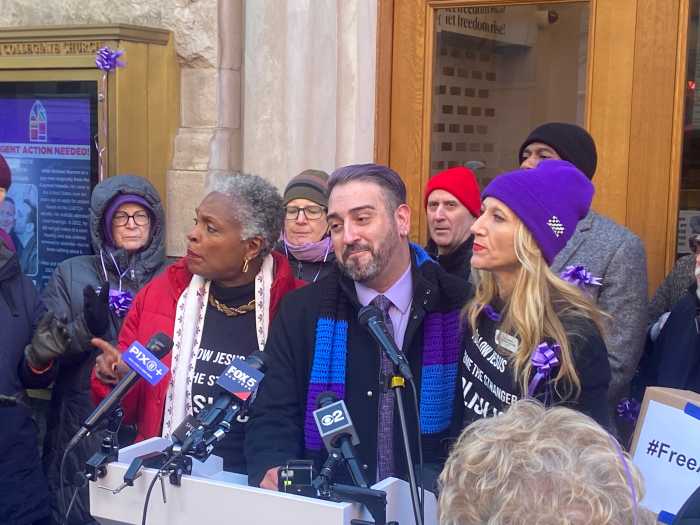 [/media-credit]
[/media-credit]
The Chinatown Partnership Local Development Corporation, initiator of the neighborhood’s forthcoming Business Improvement District, has partnered with Direct Environmental Corp., also known as D.E.C. Green, a Bronx-based distributor and manufacturer, to install a solar-powered, digitalized trash compactor on the southeast corner of Canal and Mott Streets.
Community leaders along with Councilmember Margaret Chin and others gathered at the Chinatown intersection last Wed., Nov. 9 to unveil the pilot compactor, dubbed, “BigBelly,” which holds five times the amount of garbage as a traditional trash receptacle and can reduce trash collection by 80 percent. The Chinatown BigBelly will join the two dozen or so others dispersed around Manhattan.
“The aim is to explore its potential usefulness for the Chinatown [Business Improvement District] area,” said Wellington Chen, executive director of the Chinatown Partnership. The B.I.D.’s sanitation committee, which will be formed in 2012, will determine which other intersections would benefit from the compactor.
“Certain locations require traditional garbage cans for traffic and a variety of [other] reasons,” said Chen. “We’re going to be very selective if we do implement it [by first] testing it out.”
The compactor, comprised of a computer and a Smartphone, connects wirelessly to the BigBelly Solar headquarters in Massachusetts. The web-based system is set up so that the BigBelly automatically tracks its own garbage load in real-time.
“It will report to a web-based program and let you know when it’s full and needs to be changed,” said Franklin Cruz, chairman of D.E.C. Green, responsible for manufacturing New York State’s BigBellies.
By applying 1250 pounds of pressure, Cruz noted, the BigBelly crushes accumulating litter, thereby clearing the way for more trash.
“Towards the top of the internal bin is a laser, which sends an impulse to the computer notifying it of any obstructions,” explained Cruz.
While celebrating the BigBelly’s installation at the corner of Canal and Mott Streets last week, Councilmember Chin dubbed the compactor the “garbage can of the future.”
“I’m so glad that Chinatown is taking this major step in collecting garbage and keeping our community clean,” said the Councilmember, who remarked on the compact size of the BigBelly (comparing it to an earlier, larger version she had seen in Flushing, Queens).
“I can’t believe I’m so excited about a garbage can!” said Community Board 3’s District Manager, Susan Stetzer. “This is a perfect example of why you need the [Chinatown] B.I.D. — who else is going to [sponsor] this?”
While the machines are valued at a pricey $4,000-a-piece, they can result in hefty overall savings for metropolitan areas, according to Cruz. Now equipped with approximately 1,000 BigBellies, the city of Philadelphia, for example, has pared down its trash collection from 17 times a week to twice a week, leading to cost reductions in citywide sanitation services of close to $1 million, according to Cruz.
Apart from economic waste, premature trash collection and landfill dumping has an adverse impact on the environment, Cruz argued.
“This will delay the need for garbage pick-ups, save on [car] fuel and wear-and-tear on the roads, and dramatically reduce carbon emissions,” said Cruz. “The point of collection is where you can make a difference.”
The relatively new form of trash collection does not have to result in layoffs of sanitation workers, Cruz assured. In the case of Philadelphia, sanitation personnel were transferred to the city’s recycling program, which was enhanced following the BigBelly installations.
The BigBelly has proven to be virtually indestructible. It weighs more than 300 pounds and is composed of recycled bumpers and polycarbonate — making it resistant to extreme temperatures and other inclement weather. One BigBelly was even discovered unharmed after being submerged in water in Port Jefferson, Long Island following Hurricane Irene, according to Cruz.
“I’ve been a distributor and assembler of the product since 2007, and I can count on the fingers of one hand how many service calls I’ve gotten,” said Cruz.
Nonetheless, Cruz recommends that the compactors be fastened to the ground, for safety reasons. “It’s possible that you could have people who just for fun want to see if they could knock it over into the street,” he said.
Chinatown community members welcomed the high-tech garbage can into their neighborhood with open arms.
“A lot of people think we’re a futile society and [do it] the old way with a broomstick,” said Chen. “This is a more innovative way to say there are greener, possible hybrid solutions to what we’re trying to tackle here.”
“And more importantly, Ratatouille cannot get inside!” said Chen, referring to Remy, the fictionalized rat in the 2007 computer-animated film, “Ratatouille.”
Studies have indeed shown that the BigBelly is impervious to rodents and helps to curb rodent infestations, according to Cruz. Following a pilot program in which three BigBellies supplanted traditional wastebaskets in Thomas Paine Park from April to October this year, urban rodentologist Robert Corrigan, a city Health Department employee, reported a migration of the rats away from the park.
An endless supply of litter that accumulates in public trash bins allows the rats to “flourish,” according to Cruz.
“[Corrigan’s] theory is that, the reason why the rat population is so difficult to control, particularly in New York, is because it’s very difficult for sanitation to keep up with emptying trash baskets; so that, if we could eliminate the food source and continue to bait, there might be some progress made in the fight against the rats in New York City,” said Cruz.





































